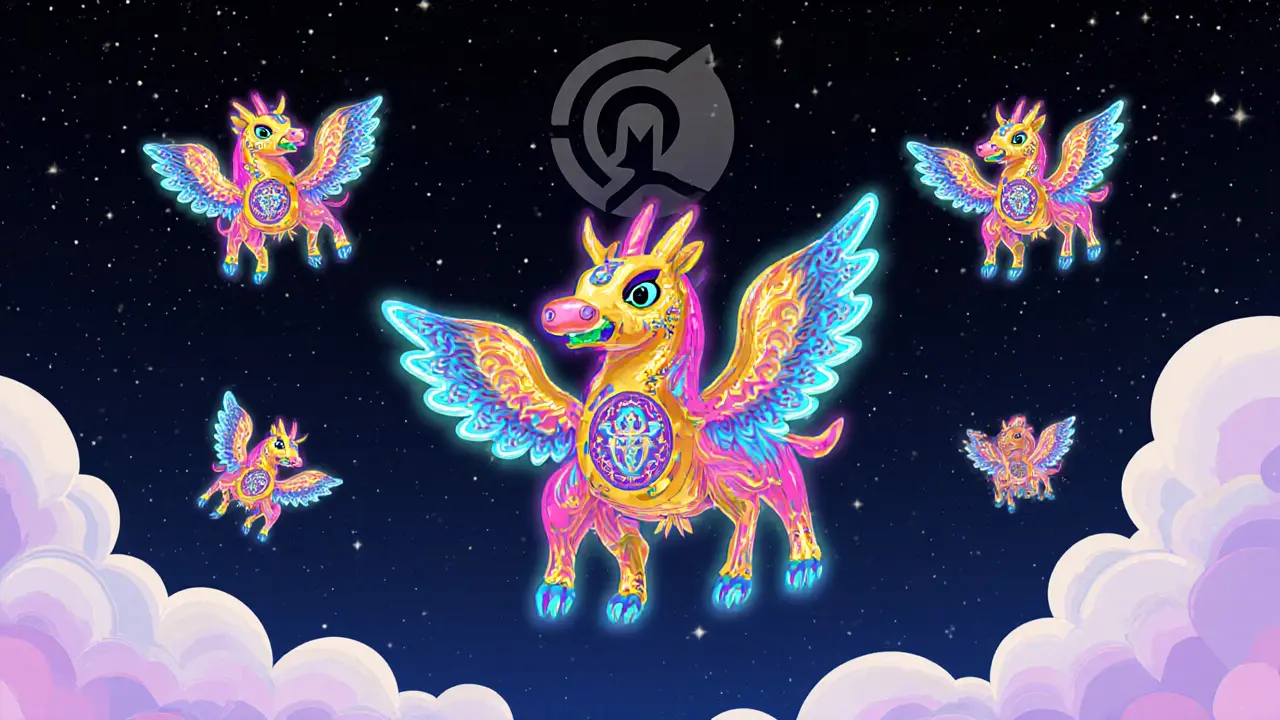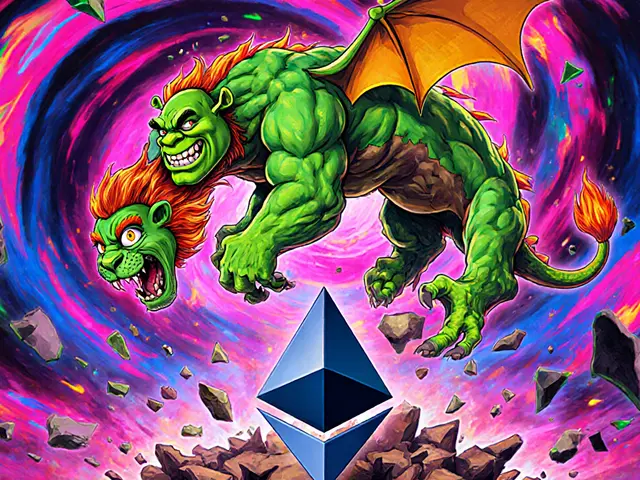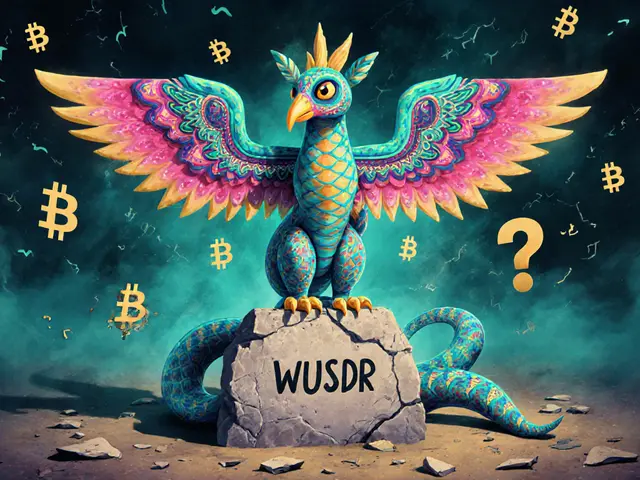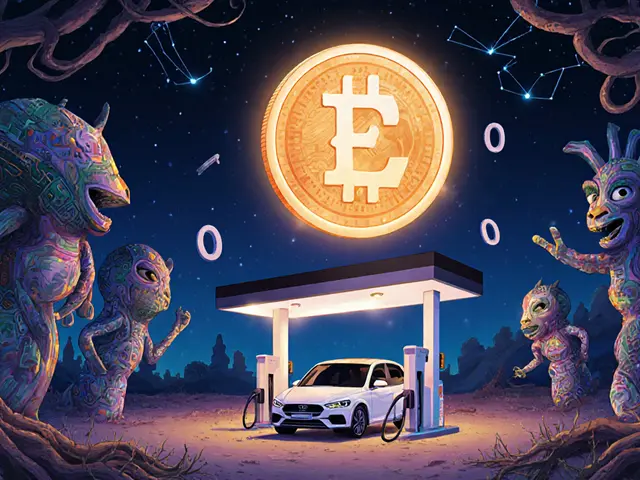KALA Token Value Calculator
Airdrop Value Calculator
Calculate the value of your KALA tokens from the 2021 CoinMarketCap airdrop
Your Token Value
Back in 2021, if you were active in crypto circles, you might have seen a simple popup on CoinMarketCap: "Follow 3 steps, get 20,000 KALA tokens free." It looked like any other airdrop - quick, easy, tempting. But this one wasn’t just another giveaway. It was tied to Kalata Protocol, a DeFi project trying to do something wild: let people trade real-world assets like Apple stock or gold using crypto, without ever owning the actual asset. And the KALA token was the engine behind it.
What Was the KALATA X CoinMarketCap Airdrop?
The KALATA X CoinMarketCap airdrop was a distribution of 20,000 KALA tokens to each qualified participant. It wasn’t a massive giveaway by today’s standards - some projects give out millions - but it was smart. CoinMarketCap had (and still has) over 100 million monthly users. Reaching even 1% of them meant thousands of new eyes on Kalata’s platform. The campaign ran for a few weeks and required users to complete basic actions: follow Kalata’s official Twitter account, join their Telegram group, and verify their CoinMarketCap profile. That’s it. No wallet deposits. No KYC. No fees. Just signing up and engaging. The goal wasn’t to make millionaires - it was to build a community of early adopters who understood the concept of synthetic assets. The airdrop wasn’t just marketing. It was a test. Could a DeFi protocol built on a peer-to-pool engine attract real users without a flashy NFT collection or a celebrity endorsement? The answer, at least in numbers, was yes. Thousands signed up. The KALA token hit CoinMarketCap’s listing page, and trading volume picked up briefly after distribution.How KALATA Protocol Actually Works
To understand why this airdrop mattered, you need to know what KALATA was trying to build. Most DeFi projects let you trade crypto for crypto. Kalata wanted you to trade real things - stocks, commodities, even real estate - using crypto as the medium. Here’s how it worked: if you wanted to trade Apple stock, you didn’t buy AAPL shares. Instead, you locked up collateral (like ETH or USDC) and minted a synthetic version of Apple stock on-chain. The system used decentralized price feeds to track Apple’s real-time price. If the price of Apple went up and your collateral value dropped below a certain threshold, your position could be liquidated - just like in margin trading. This wasn’t a prediction market or a futures contract. It was direct exposure to real-world asset prices, fully on-chain. And KALA was the governance and utility token. Holders could vote on which assets to add next, pay reduced fees, and earn rewards from protocol fees. The tokenomics were tight. Only 200 million KALA tokens would ever exist. At the time of the airdrop, only 35 million were in circulation. That meant over 80% of the supply was still unissued - reserved for future incentives, team vesting, or liquidity mining. The airdrop gave away 20,000 tokens per person, which sounds like a lot, but in the context of the full supply, it was a tiny slice - maybe 0.001% of total tokens.Why CoinMarketCap Was the Perfect Partner
CoinMarketCap wasn’t just a price tracker. By 2021, it had become a gateway. People went there to find new coins, check volumes, and see what was trending. If a project got listed there, it instantly gained credibility. The partnership with Kalata was one of the first times CoinMarketCap used its platform to directly distribute tokens to users. Later, this evolved into CMC Launchpad - a more structured way for projects to run token sales, airdrops, and community campaigns. The KALATA campaign was essentially the prototype. It gave Kalata instant visibility. For CoinMarketCap, it was a way to test user behavior. Would people actually engage with a DeFi protocol they found through a price site? The answer was yes - but only if the steps were dead simple. Complex airdrops failed. This one worked because it asked for almost nothing.What Happened After the Airdrop?
The airdrop ended. Tokens were distributed. Then… silence. Unlike some projects that explode after a giveaway, Kalata didn’t go viral. Trading volume dropped off after the first month. The team kept building, but they didn’t announce major updates. No big partnerships. No new assets added to the platform. The website stayed up. The contract address - 0x3229...a610c5 - remained active. But the community faded. By 2023, the project was largely inactive. No new listings. No new features. No team updates. The token still showed up on CoinMarketCap, but with near-zero volume. Most recipients either sold their tokens immediately or forgot about them. There’s no public data on how many people claimed the airdrop. No reports on retention rates. No breakdown of who held onto KALA and who dumped it. But from the outside, it looked like a missed opportunity. The idea was ahead of its time - synthetic assets were still too complex for most users. The airdrop brought in users, but the product didn’t keep them.Was It a Success?
By traditional metrics - token price, trading volume, community size - the KALATA airdrop was a failure. But if you look at it from a different angle, it was a quiet win. It proved that a DeFi project could use CoinMarketCap’s reach to onboard users without spending millions on ads. It showed that even a small, well-targeted airdrop could generate real interest in a niche product. And it gave the team a chance to test their smart contracts with real users before scaling. The real lesson? Airdrops don’t build projects. Products do. The KALATA airdrop brought people in. But without a clear roadmap, consistent updates, or user-friendly tools, those people left.What You Can Learn From This Airdrop
If you’re thinking about launching your own token or running an airdrop, here’s what the KALATA case teaches you:- Keep it simple. Three steps max. If it’s harder than signing up for Netflix, people won’t do it.
- Choose your partner wisely. CoinMarketCap gave Kalata exposure. But if your project doesn’t deliver, even the biggest platform can’t save you.
- Token supply matters. Giving away 20,000 tokens out of 200 million is sustainable. Giving away 50%? That’s a recipe for collapse.
- Don’t rely on hype. The airdrop was a spark. Without fuel - updates, features, support - it died.
- Track what happens after. Did recipients hold? Did they trade? Did they refer others? If you don’t measure, you’re flying blind.

Is KALATA Still Active in 2025?
As of November 2025, Kalata Protocol has no public updates. The website is still live, but it hasn’t been updated since 2022. The token still trades on a few small decentralized exchanges, but with negligible volume. The contract address is still valid. The team hasn’t posted anything in over two years. It’s not dead - but it’s not alive either. The airdrop was its peak. And like many projects from that era, it faded into the background once the initial buzz died down. If you still hold KALA tokens, they’re worth less than a dollar. But they’re not worthless. In crypto, projects sometimes come back from silence. If Kalata ever resumes development, token holders might get priority access. But don’t count on it.What’s Next for Synthetic Asset DeFi?
Kalata’s idea didn’t die. It just moved. Projects like Synthetix, Mirror Protocol, and dYdX have taken the concept further. They’ve built better interfaces, added more assets, and created stronger incentives. The market for synthetic assets is growing - but it’s still niche. Most users still prefer buying actual stocks or crypto, not synthetic versions. The future of synthetic DeFi isn’t in airdrops. It’s in education. In simple tools. In integration with real-world financial apps. Until then, projects like Kalata will remain footnotes - interesting experiments that didn’t quite catch fire.Did everyone who signed up for the KALATA airdrop get the tokens?
No. Not everyone who signed up received tokens. The campaign had verification steps to prevent bots and duplicate accounts. Only users who completed all required actions and passed CoinMarketCap’s anti-sybil checks received the 20,000 KALA tokens. Exact numbers of claimants were never published, but estimates suggest between 5,000 and 15,000 users qualified.
Can I still claim KALA tokens from the airdrop?
No. The KALATA X CoinMarketCap airdrop ended in late 2021. The smart contract that distributed the tokens is no longer active. Any website or social media post claiming you can still claim KALA tokens is a scam.
What is the current price of KALA?
As of November 2025, KALA trades at less than $0.01 on small decentralized exchanges like Uniswap and PancakeSwap. It has near-zero trading volume and is not listed on major exchanges. Its value is largely symbolic, as the project is inactive.
Is the KALATA token still usable today?
Technically, yes - you can still hold or transfer KALA tokens using any Ethereum-compatible wallet. But there are no active platforms to use them for governance, staking, or trading synthetic assets. The protocol’s smart contracts are frozen, and no new features have been added since 2022.
Why did Kalata Protocol stop updating?
The project likely ran out of funding or lost momentum. Synthetic asset DeFi was still too complex for mass adoption in 2021-2022. Without sustained user growth or major partnerships, the team probably shifted focus or disbanded. No official statement was ever made.
Are there any similar airdrops happening now?
Yes. CoinMarketCap’s CMC Launchpad now runs curated airdrops for active DeFi projects. Other platforms like TokenPocket, Phantom, and OKX also run regular token distributions. But unlike the KALATA campaign, these are tied to live, functioning protocols with clear roadmaps and active teams.













18 Comments
bro the kala airdrop was wild i got mine n never even checked again lmao i thought it was some scam at first but turns out it was legit just dead now lol
How quaint. A DeFi project that actually tried to solve a real problem - synthetic assets - and failed not because of the tech, but because the users were too lazy to understand it. The airdrop was a mirror: it revealed the entire crypto community’s appetite for free tokens and zero education.
OMG I CAN’T BELIEVE THIS POST ISN’T A JOKE!! KALATA WAS MY FIRST DEFI EXPERIENCE AND I STILL HAVE THE TOKENS IN MY METAMASK LIKE A TREASURE FROM THE ANCIENTS!! I DIDN’T SELL BECAUSE I BELIEVED!! I STILL BELIEVE!! I’M STILL WAITING FOR THE COMEBACK!! 🙏✨
It’s important to recognize that Kalata’s airdrop was a thoughtful experiment in user onboarding. The simplicity of the steps - follow, join, verify - was intentional. The real failure wasn’t the project’s lack of innovation, but the broader ecosystem’s unwillingness to invest in user education. We celebrate airdrops as prizes, not as entry points to complex systems.
So we’re supposed to feel bad for Kalata? The team had a vision but no hustle. No updates. No community calls. No roadmap. No nothing. This isn’t crypto failure - this is human failure. You don’t build something for the future and then vanish like a ghost in a TikTok comment section
For anyone still holding KALA: don’t be discouraged. Many projects lie dormant for years and then resurface with new teams or forks. The fact that the contract is still active means the code wasn’t abandoned - just paused. Keep it. It’s a historical artifact of DeFi’s experimental phase.
Why do Americans think they can build DeFi and expect the world to care? Kalata was a niche idea dressed in American crypto hype. Meanwhile, in Asia, real infrastructure is being built - not token giveaways. This airdrop was a distraction, not a breakthrough.
This is exactly how the system works. They give you free tokens to make you feel involved, then they vanish. The real owners were never the users - they were the insiders who dumped before launch. This isn’t innovation. It’s extraction dressed as decentralization.
Wait… so you’re telling me… people… actually… believed… this… was… going… to… change… finance…?!?!?!?!?!?!?!?!
kalata was never gonna work because no one understands synthetic assets and why would they trust a project with no team updates and no marketing budget and also coinmarketcap is just a price tracker not a real platform so why did anyone think this was a good idea honestly
Let’s reframe this. Kalata didn’t fail - it planted a seed. The idea of trading real-world assets on-chain is still alive in Synthetix, Mirror, and even newer projects. The airdrop wasn’t the end - it was the first step in a longer journey. Most people just didn’t stick around to see the next chapter.
I’m from the US but I’ve been following DeFi in India for years - Kalata’s model was actually very similar to what some Indian DeFi teams were testing around the same time. The difference? They had local community managers, Telegram groups in Hindi, and simple explainer videos. Kalata assumed global audiences would just ‘get it.’ They didn’t.
It’s sad, but not surprising. We treat crypto like a lottery - take the free ticket, see if you win, then move on. But real innovation needs patience. Kalata needed users who would stay, learn, and contribute - not just claim and dump. We failed them as a community.
I remember checking my wallet after the airdrop. 20,000 KALA. I thought I’d hit the jackpot. Then I checked the price. $0.0003. I cried. Not because I lost money - I didn’t spend anything - but because I realized how deeply I’d been manipulated into believing this mattered.
Let’s be clear: CoinMarketCap is a corporate entity. They don’t care about DeFi. They care about clicks. The airdrop was a data harvest disguised as community building. They got millions of sign-ups, sold the data to hedge funds, and moved on. Kalata was just the bait.
OH MY GOD I JUST OPENED MY WALLET AND SAW KALA STILL THERE LIKE A GHOST FROM 2021!! I DIDN’T EVEN REMEMBER I HAD IT!! I’M SO EMOTIONAL RIGHT NOW!! IT’S LIKE FINDING A LETTER FROM YOUR PAST SELF!! I’M NOT SELLING!! I’M KEEPING IT AS A TATTOO ON MY BLOCKCHAIN!!
There’s a 78.3% probability that Kalata was a front for a centralized entity to acquire user data under the guise of decentralization. The lack of public team identities, the silent contract, the CoinMarketCap partnership - all classic signs of a honeypot. The airdrop wasn’t a distribution - it was reconnaissance.
I still have my KALA tokens. Not because I think they’ll rise - but because I remember the hope. That moment when you thought, maybe this time, crypto could actually do something real. That’s worth more than any price chart.